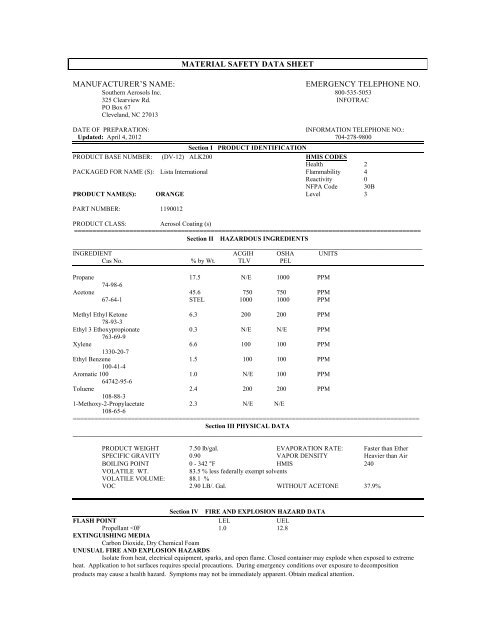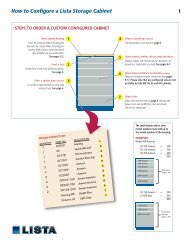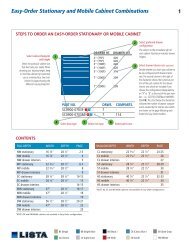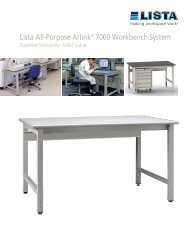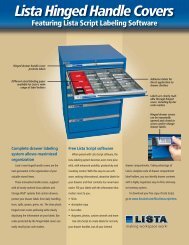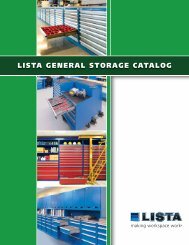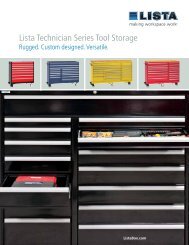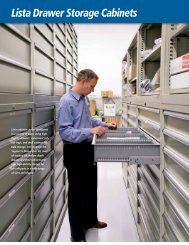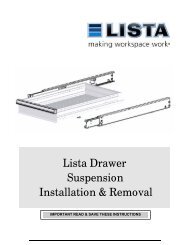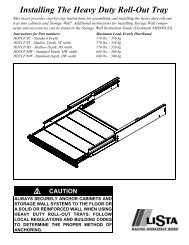Orange - Lista
Orange - Lista
Orange - Lista
Create successful ePaper yourself
Turn your PDF publications into a flip-book with our unique Google optimized e-Paper software.
MATERIAL SAFETY DATA SHEETMANUFACTURER’S NAME:EMERGENCY TELEPHONE NO.Southern Aerosols Inc. 800-535-5053325 Clearview Rd. INFOTRACPO Box 67Cleveland, NC 27013DATE OF PREPARATION:INFORMATION TELEPHONE NO.:Updated: April 4, 2012 704-278-9800Section I PRODUCT IDENTIFICATIONPRODUCT BASE NUMBER: (DV-12) ALK200 HMIS CODESHealth 2PACKAGED FOR NAME (S): <strong>Lista</strong> International Flammability 4Reactivity 0NFPA Code 30BPRODUCT NAME(S): ORANGE Level 3PART NUMBER: 1190012PRODUCT CLASS:Aerosol Coating (s)==============================================================================================Section II HAZARDOUS INGREDIENTS____________________________________________________________________________________________________________INGREDIENT ACGIH OSHA UNITSCas No. % by Wt. TLV PELPropane 17.5 N/E 1000 PPM74-98-6Acetone 45.6 750 750 PPM67-64-1 STEL 1000 1000 PPMMethyl Ethyl Ketone 6.3 200 200 PPM78-93-3Ethyl 3 Ethoxypropionate 0.3 N/E N/E PPM763-69-9Xylene 6.6 100 100 PPM1330-20-7Ethyl Benzene 1.5 100 100 PPM100-41-4Aromatic 100 1.0 N/E 100 PPM64742-95-6Toluene 2.4 200 200 PPM108-88-31-Methoxy-2-Propylacetate 2.3 N/E N/E108-65-6===============================================================================================Section III PHYSICAL DATA____________________________________________________________________________________________________________PRODUCT WEIGHT 7.50 lb/gal. EVAPORATION RATE: Faster than EtherSPECIFIC GRAVITY 0.90 VAPOR DENSITY Heavier than AirBOILING POINT 0 - 342 °F HMIS 240VOLATILE WT.83.5 % less federally exempt solventsVOLATILE VOLUME: 88.1 %VOC 2.90 LB/. Gal. WITHOUT ACETONE 37.9%Section IV FIRE AND EXPLOSION HAZARD DATAFLASH POINT LEL UELPropellant
SPECIAL FIRE FIGHTING PROCEDURESFull protective equipment including self-contained breathing apparatus should be used. Water spray may be ineffective. Ifwater is used, fog nozzles are preferable. Water may be used to cool closed containers to prevent pressure build-up and possible autoignition or explosion when exposed to extreme heat.Section V HEALTH HAZARD DATAROUTES OF EXPOSUREExposure may be by INHALATION and/or SKIN or EYE contact, depending on conditions of use. To minimize exposure, followrecommendations for proper use, ventilation, and personal protective equipment.ACUTE Health HazardsEFFECTS OF OVEREXPOSUREIrritation of eyes, skin and respiratory system. May cause nervous system depression. Extreme overexposure may result inunconsciousness and possibly death.SIGNS AND SYMPTOMS OF OVEREXPOSUREHeadache, dizziness, nausea, and loss of coordination are indications of excessive exposure to vapors or spray mists.Redness and itching or burning sensation may indicate eye or excessive skin exposure.MEDICAL CONDITIONS AGGRVATED BY EXPOSURE: None generally recognized.EMERGENCY AND FIRST AID PROCEDURESIf INHALED: If affected, remove from exposure. Restore breathing. Keep warm and quiet.If on SKIN: Wash affected area thoroughly with soap and water. Remove contaminated clothing and launderbefore reuse.If in EYES Flush eyes with large amount of water for 15 minutes. Get medical attention.If SWALLOWED Never give anything by mouth to an unconscious person. DO NOT INDUCE VOMITING.Seek medical attention.CHRONIC HEALTH HAZARDSNo ingredient in this product is an IARC, NTP or OSHA listed carcinogen. Prolonged overexposure to solvent ingredientsin Section II may cause adverse effects to the liver, urinary, cardiovascular and reproductive systems. Reports have associatedrepeated and prolonged overexposure to solvents with permanent brain and nervous system damage.Section VIREACTIVITY DATASTABILITY:CONDITONS TO AVOID:INCOMPATIBILITYHAZARDOUS DECOMPOSITION PRODUCTS:HAZARDOUS POLYMERIZATIONSection VIIStableNone knownNone KnownBy fire: Carbon Monoxide, Carbon DioxideWill not occur.SPILL OR LEAK PROCEDURESSTEPS TO BE TAKEN IN CASE MATERIAL IS RELEASED OR SPILLED:Remove all sources of ignition. Ventilate and remove with inert absorbent.WASTE DISPOSAL METHOD:Waste from this product may be hazardous as defined under the Resource Conversation and Recover Act (RCRA) 40 CFR261. Waste must be tested for ignitability to determine the applicable EPA hazardous waste numbers. Do not incinerate.Depressurize container. Dispose of in accordance with Federal, State and Local regulations regarding pollution.===============================================================================================Section VIII PROTECTION INFORMATIONPRECAUTIONS TO BE TAKEN IN USE:Use only with adequate ventilation. Avoid breathing vapor and spray mist. Avoid contact with skin and eyes. Wash handsafter using.This coating may contain material classified as nuisance particulates (listed “As Dust” in Section II) which may be presentat hazardous levels only during sanding or abrading of the dried film. If no specific dusts are listed in Section II, The applicable limitsfor nuisance dusts are ACGIH TLV 10 mg/m3 (total dust), OSHA PEL 15 mg/m3 (total dust), 5mg/m3 (respirable fraction).Local exhaust preferable. General exhaust acceptable if the exposure to materials in Section II is maintained belowapplicable exposure limits. Refer to OSHA Standards 1910.94, 1910.107, 1910.108.RESPIRATORY PROTECTIONIf personal exposure can not be controlled below applicable limits by ventilation, wear a properly fitted organicvapor/particulate respirator approved by NIOSH/MSHA for protection against materials in Section II.When sanding or abrading the fried film, wear a dust/mist respirator approved by NIOSH/MSHA for dust, which may be generatedfrom this product, underlying paint, or the abrasive.PROTECTIVE GLOVESNone required for normal application of aerosol products where minimal skin contact is expected. For long or repeatedcontact, wear chemical resistant gloves.EYE PROTECTIONWear safety spectacles with unperforated side shields.
Section IXPRECAUTIONSDOL STORAGE CATEGORY:1APRECAUTIONS TO BE TAKEN IN HANDLING AND STORING:Keep away from heat, sparks, and open flame. Vapors will accumulate readily and may ignite explosively.During use and until all vapors are gone: Keep area ventilated, do not smoke, and extinguish all flames, pilot lights andheaters. Turn off stoves, electric tools and appliances, and any other source of ignition.Consult NFPA code. Use approved Bonding and Grounding procedures.Contents under pressure. Do not puncture, incinerate, or expose to temperature above 120°F.Heat from sunlight, radiators, stoves, hot water and other heat sources could cause container to burst. Do not takeinternally. Keep out of the reach of children.OTHER PRECAUTIONS:Intentional misuse by deliberately concentrating and inhaling the contents can be harmful or fatal.Section XOTHER REGULATORY INFORMATIONSARA 313 (40CFR 372.65C) SUPPLIER NOTIFICATIONCas. No. Chemical/Compound % By Wt.1330-20-7 Xylene 6.6 %78-93-3 Methyl Ethyl Ketone 6.3 %100-41-4 Ethyl Benzene 1.5 %108-88-3 Toluene 2.4 %Section XI TRANSPORTATION INFORMATIONPROPER SHIPPING NAME HAZARD CLASS UN NUMBER PACKING GROUPConsumer Commodity ORM-D Does Not Apply Does Not ApplyCALIFORNIA PROPOSITION 65This product contains chemical(s) known to the State of California to cause cancer and birth defects or other reproductiveharm.===============================================================================================All components of this product are listed in the U.S. TSCA Chemical Substance Inventory.The above information pertains to this product as currently formulated, and is based on the information available at thistime. Addition of reducers or other additives to the product may substantially alter the composition and hazards of the product. Sinceconditions of use are outside our control, we make no warranties, express or implied, and assume no liability in connection with anyuse of this information.


